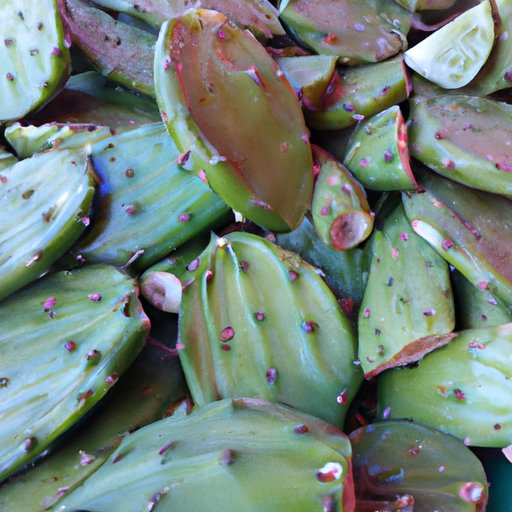Introduction
Nopales, or cactus paddles, have been a staple food in Mexico and Central America for centuries. These edible cacti are packed with vitamins, minerals, and other nutrients that can help promote overall health and wellness. In this article, we’ll explore the nutritional profile of nopales, their health benefits, and how to incorporate them into your diet.
Exploring the Nutritional Profile of Nopales
Nopales are low in calories but high in fiber, which makes them a great choice for those looking to lose weight. They are also an excellent source of Vitamin A and C, both of which are essential for healthy skin and eyesight. Additionally, nopales contain magnesium, potassium, and iron, all of which are important for maintaining proper bodily functions.
Nopales are also rich in antioxidants, which are compounds that help protect your cells from oxidative damage caused by free radicals. Antioxidants can help reduce inflammation and protect against certain diseases, such as cancer and heart disease.

Health Benefits of Eating Nopales
The health benefits of eating nopales are numerous. For starters, they are a good source of dietary fiber, which helps keep you feeling full longer and aids in digestion. Additionally, the antioxidants found in nopales can help reduce inflammation, which can lead to better overall health. They are also a good source of iron, which is essential for red blood cell production and oxygen transport throughout the body.
Additionally, the Vitamin A and C found in nopales can help improve your immune system, while the magnesium and potassium can help regulate blood pressure and reduce the risk of stroke and heart attack. Finally, nopales are a great source of plant-based protein, making them an ideal option for vegetarians and vegans.

How to Incorporate Nopales Into Your Diet
There are many ways to incorporate nopales into your diet. They can be used as a side dish, added to salads, or even cooked up in a stir-fry. Here are a few tips for adding nopales to meals:
- Sauté chopped nopales with onions, garlic, and spices for a flavorful side dish.
- Add diced nopales to salads for a crunchy texture and extra nutrition.
- Stuff roasted nopales with cheese and vegetables for a delicious meal.
- Blend nopales with avocado, lime juice, and cilantro for a zesty dip.
To help get you started, here are a few healthy nopales recipes to try:
- Grilled Nopales with Onion and Garlic
- Nopales Breakfast Burrito
- Nopales and Black Bean Salad
- Nopales Enchiladas
A Guide to Selecting, Preparing, and Storing Nopales
When shopping for nopales, look for paddles that are firm and bright green in color. Avoid ones that are soft, discolored, or have spots of mold. To prepare the nopales, first use a knife or vegetable peeler to remove the spines, then rinse them under cold running water. Finally, dice or slice the paddles into whatever size pieces you need for your recipe.
Once prepared, nopales should be stored in an airtight container in the refrigerator. They will last up to a week when stored properly.
Conclusion
Nopales are an incredibly nutritious and versatile food that can be incorporated into a variety of dishes. Not only are they low in calories and high in fiber, but they are also packed with vitamins, minerals, and antioxidants that can help promote overall health and wellness. By following the tips outlined in this article and trying out some of the tasty nopales recipes, you can easily add this nutrient-dense ingredient to your diet.
Whether you’re looking to lose weight, reduce inflammation, or simply boost your overall health, nopales are a great choice.
(Note: Is this article not meeting your expectations? Do you have knowledge or insights to share? Unlock new opportunities and expand your reach by joining our authors team. Click Registration to join us and share your expertise with our readers.)
